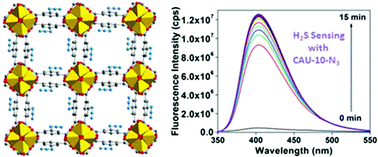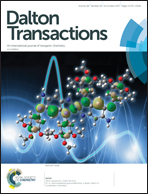Rapid and highly sensitive detection of extracellular and intracellular H2S by an azide-functionalized Al(iii)-based metal–organic framework†
Abstract
A new, azide-functionalized Al(III)-based metal–organic framework (MOF) denoted as CAU-10-N3 (1, CAU = Christian-Albrechts-University) and consisting of the 5-azido-isophthalic acid (H2IPA-N3) ligand was employed as a reaction-based fluorescent turn-on probe for the detection of H2S. The activated compound (1′) showed fast, selective and highly sensitive sensing properties for extracellular H2S in HEPES buffer (10 mM, pH = 7.4). The material retained its high selectivity even in the presence of possibly competing biological species. The limit of detection of 1′ for H2S is 2.65 μM, which is lower than the earlier reports on MOFs for H2S sensing. The material displayed a short response time (420 s) and a significant increase (20-fold and 26-fold after 1 and 7 min of addition of Na2S, respectively) in the fluorescence intensity towards H2S. Macrophage cells loaded with probe 1′ exhibited blue fluorescence with a response time of 15 min after Na2S addition, indicating the suitability of the probe for intracellular H2S detection. Moreover, CAU-10-N3 featured excellent detection performance (quick response and 32-fold increment in fluorescence intensity after 7 min of Na2S addition) in water. Hence, it can be utilized to regulate the H2S level in aqueous samples collected from the environment.



 Please wait while we load your content...
Please wait while we load your content...